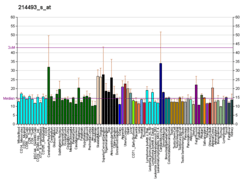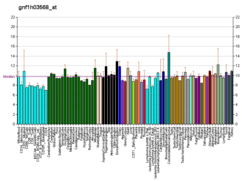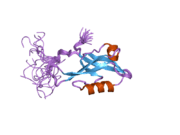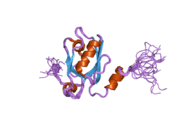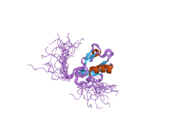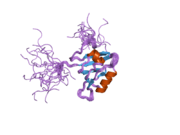INADL
InaD-like protein is a protein that in humans is encoded by the INADL gene.[5][6][7]
Function
This gene encodes a protein with multiple PDZ domains. PDZ domains mediate protein-protein interactions, and proteins with multiple PDZ domains often organize multimeric complexes at the plasma membrane. This protein localizes to tight junctions and to the apical membrane of epithelial cells. A similar protein in Drosophila is a scaffolding protein which tethers several members of a multimeric signaling complex in photoreceptors.[7]
Interactions
References
- 1 2 3 GRCh38: Ensembl release 89: ENSG00000132849 - Ensembl, May 2017
- 1 2 3 GRCm38: Ensembl release 89: ENSMUSG00000061859 - Ensembl, May 2017
- ↑ "Human PubMed Reference:".
- ↑ "Mouse PubMed Reference:".
- ↑ Philipp S, Flockerzi V (Sep 1997). "Molecular characterization of a novel human PDZ domain protein with homology to INAD from Drosophila melanogaster". FEBS Lett. 413 (2): 243–8. doi:10.1016/S0014-5793(97)00877-6. PMID 9280290.
- ↑ Soejima H, Kawamoto S, Akai J, Miyoshi O, Arai Y, Morohka T, Matsuo S, Niikawa N, Kimura A, Okubo K, Mukai T (May 2001). "Isolation of novel heart-specific genes using the BodyMap database". Genomics. 74 (1): 115–20. doi:10.1006/geno.2001.6527. PMID 11374908.
- 1 2 "Entrez Gene: INADL InaD-like (Drosophila)".
- ↑ Roh MH, Makarova O, Liu CJ, Shin K, Lee S, Laurinec S, Goyal M, Wiggins R, Margolis B (Apr 2002). "The Maguk protein, Pals1, functions as an adapter, linking mammalian homologues of Crumbs and Discs Lost". J. Cell Biol. 157 (1): 161–72. doi:10.1083/jcb.200109010. PMC 2173254. PMID 11927608.
Further reading
- Fanning AS, Anderson JM (1999). "PDZ domains: fundamental building blocks in the organization of protein complexes at the plasma membrane". J. Clin. Invest. 103 (6): 767–72. doi:10.1172/JCI6509. PMC 408156. PMID 10079096.
- Lennon G, Auffray C, Polymeropoulos M, Soares MB (1996). "The I.M.A.G.E. Consortium: an integrated molecular analysis of genomes and their expression". Genomics. 33 (1): 151–2. doi:10.1006/geno.1996.0177. PMID 8617505.
- Kurschner C, Mermelstein PG, Holden WT, Surmeier DJ (1998). "CIPP, a novel multivalent PDZ domain protein, selectively interacts with Kir4.0 family members, NMDA receptor subunits, neurexins, and neuroligins". Mol. Cell. Neurosci. 11 (3): 161–72. doi:10.1006/mcne.1998.0679. PMID 9647694.
- Vaccaro P, Brannetti B, Montecchi-Palazzi L, Philipp S, Helmer Citterich M, Cesareni G, Dente L (2001). "Distinct binding specificity of the multiple PDZ domains of INADL, a human protein with homology to INAD from Drosophila melanogaster". J. Biol. Chem. 276 (45): 42122–30. doi:10.1074/jbc.M104208200. PMID 11509564.
- Anzai N, Deval E, Schaefer L, Friend V, Lazdunski M, Lingueglia E (2002). "The multivalent PDZ domain-containing protein CIPP is a partner of acid-sensing ion channel 3 in sensory neurons". J. Biol. Chem. 277 (19): 16655–61. doi:10.1074/jbc.M201087200. PMID 11872753.
- Roh MH, Makarova O, Liu CJ, Shin K, Lee S, Laurinec S, Goyal M, Wiggins R, Margolis B (2002). "The Maguk protein, Pals1, functions as an adapter, linking mammalian homologues of Crumbs and Discs Lost". J. Cell Biol. 157 (1): 161–72. doi:10.1083/jcb.200109010. PMC 2173254. PMID 11927608.
- Lemmers C, Médina E, Delgrossi MH, Michel D, Arsanto JP, Le Bivic A (2002). "hINADl/PATJ, a homolog of discs lost, interacts with crumbs and localizes to tight junctions in human epithelial cells". J. Biol. Chem. 277 (28): 25408–15. doi:10.1074/jbc.M202196200. PMID 11964389.
- Roh MH, Liu CJ, Laurinec S, Margolis B (2002). "The carboxyl terminus of zona occludens-3 binds and recruits a mammalian homologue of discs lost to tight junctions". J. Biol. Chem. 277 (30): 27501–9. doi:10.1074/jbc.M201177200. PMID 12021270.
- Makarova O, Roh MH, Liu CJ, Laurinec S, Margolis B (2003). "Mammalian Crumbs3 is a small transmembrane protein linked to protein associated with Lin-7 (Pals1)". Gene. 302 (1–2): 21–9. doi:10.1016/S0378111902010843. PMID 12527193.
- Roh MH, Fan S, Liu CJ, Margolis B (2004). "The Crumbs3-Pals1 complex participates in the establishment of polarity in mammalian epithelial cells". J. Cell Sci. 116 (Pt 14): 2895–906. doi:10.1242/jcs.00500. PMID 12771187.
- Li Y, Karnak D, Demeler B, Margolis B, Lavie A (2005). "Structural basis for L27 domain-mediated assembly of signaling and cell polarity complexes". EMBO J. 23 (14): 2723–33. doi:10.1038/sj.emboj.7600294. PMC 514954. PMID 15241471.
- Michel D, Arsanto JP, Massey-Harroche D, Béclin C, Wijnholds J, Le Bivic A (2005). "PATJ connects and stabilizes apical and lateral components of tight junctions in human intestinal cells". J. Cell Sci. 118 (Pt 17): 4049–57. doi:10.1242/jcs.02528. PMID 16129888.
- Stiffler MA, Grantcharova VP, Sevecka M, MacBeath G (2007). "Uncovering Quantitative Protein Interaction Networks for Mouse PDZ Domains using Protein Microarrays". J. Am. Chem. Soc. 128 (17): 5913–22. doi:10.1021/ja060943h. PMC 2533859. PMID 16637659.
- Wells CD, Fawcett JP, Traweger A, Yamanaka Y, Goudreault M, Elder K, Kulkarni S, Gish G, Virag C, Lim C, Colwill K, Starostine A, Metalnikov P, Pawson T (2006). "A Rich1/Amot complex regulates the Cdc42 GTPase and apical-polarity proteins in epithelial cells". Cell. 125 (3): 535–48. doi:10.1016/j.cell.2006.02.045. PMID 16678097.
External links
- INADL human gene location in the UCSC Genome Browser.
- INADL human gene details in the UCSC Genome Browser.
This article is issued from
Wikipedia.
The text is licensed under Creative Commons - Attribution - Sharealike.
Additional terms may apply for the media files.





